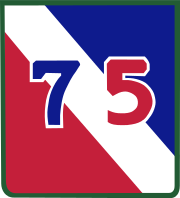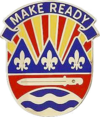| 75th Innovation Command (75th IC) | |
|---|---|
 75th IC shoulder sleeve insignia | |
| Active |
1943–1945 1952–1957 1993–present |
| Country | United States |
| Branch | U.S. Army |
| Type | Future force development for the Army Reserve |
| Size | Command |
| Headquarters | Houston, Texas |
| Motto(s) | Make Ready |
| Engagements | |
| Decorations | Meritorious Unit Commendation |
| Commanders | |
| Commander | MG James V. "Boe" Young |
| Notable commanders | MG Ray E. Porter |
| Insignia | |
| Distinctive unit insignia | |
The 75th Innovation Command (75th IC) is a separate command of the United States Army Reserve with the mission to "preparing to 'Make Ready' for the future" and drive operational innovation, concepts, and capabilities to enhance the readiness and lethality of the future force by leveraging the unique skills, agility, and private sector connectivity of America's Army Reserve.[1]
The 75th IC started as the 75th Infantry Division in World War II and was also active from 1952 to 1957 as a combat division of the United States Army Organized Reserves. In 1993, the division was reactivated as the 75th Division (Training Support) in the Army Reserve, which in later years became designated the 75th Training Command. In January 2003, numerous units of the 75th were mobilized to train other Army Reserve and National Guard units deploying overseas in support of Operation Iraqi Freedom/Operation Enduring Freedom (OIF/OEF). In January 2018, the 75th was reorganized into the 75th Innovation Command with its training divisions reassigned to the 84th Training Command.[2]
Lineage[]
- Constituted 24 December 1942, in the Army of the United States as Headquarters, 75th Infantry Division.
- Activated 15 April 1943, at Fort Leonard Wood, Missouri.
- Moved to Louisiana Maneuver Area on 24 January 1944, where it participated in the 4th Army # 6 Louisiana maneuvers.
- Transferred to Camp Breckinridge, Kentucky on 7 April 1944.
- Staged at Camp Shanks, New York, on 7 November 1944.
- Deployed from New York Port of Embarkation on 14 November 1944.
- Arrived in England on 22 November 1944. Some troops spent time training at Seabank Hotel in Porthcawl, Wales.[3]
- Assigned 9 December 1944, to the Ninth Army, which was part of the 12th Army Group.
- Further assigned 11 December 1944, to the XVI Corps.
- Landed in France on 13 December 1944.
- Crossed over into the Netherlands on 18 December 1944.
- Further assigned 22 December 1944, to the VII Corps, First Army (attached to the British 21st Army Group), 12th Army Group.
- Further assigned 29 December 1944 to the XVIII (Abn) Corps.
- Further assigned 2 January 1945 to the VII Corps.
- Further assigned 7 January 1945 to the XVIII (Abn) Corps.
- Further assigned 25 January 1945 to the 6th Army Group.
- Further assigned 30 January 1945 to the XXI Corps, Seventh Army, 6th Army Group, but attached for operations to the First French Army, 6th Army Group.
- Further assigned 11 February 1945 to the Seventh Army, 6th Army Group.
- Further assigned 14 February 1945 to the 12th Army Group.
- Further assigned 17 February 1945 to the Ninth Army, 12th Army Group, but attached to the British Second Army for operations and the British VIII Corps for administration. Entered Belgium.
- Withdrew to the Netherlands on 18 February 1945.
- Finally assigned 1 March 1945 to the XVI Corps, Ninth Army, 12th Army Group.
- Entered Germany on 10 March 1945.
- Was located at Werdohl, Germany, on 14 August 1945
- Returned to Continental US at Hampton Roads Port of Embarkation on 14 November 1945, and proceeded to Camp Patrick Henry, Virginia.
- Inactivated 14 November 1945, at Camp Patrick Henry, Virginia.
- Allotted 21 February 1952, to the Organized Reserve Corps.
- Activated 1 March 1952, at Houston, Texas.
- (Organized Reserve Corps redesignated 9 July 1952, as the Army Reserve).
- Inactivated 15 February 1957, at Houston, Texas.
- Redesignated 1 October 1993, as Headquarters, 75th Division (Exercise), and activated at Houston, Texas.
- Reorganized and redesignated 17 October 1999 as Headquarters, 75th Division (Training Support).
- Redesignated 2 November 2007 as 75th Battle Command Training Division (BCTD)
- Redesignated 1 October 2011 as 75th Training Division (Mission Command), later 75th Training Command (Mission Command)
- Redesignated Januardy 2018 as 75th Innovation Command[1]
World War II[]
Units[]
- Headquarters, 75th Infantry Division
- 289th Infantry Regiment
- 290th Infantry Regiment
- 291st Infantry Regiment
- Headquarters and Headquarters Battery, 75th Infantry Division Artillery
- 730th Field Artillery Battalion (155 mm)
- 897th Field Artillery Battalion (105 mm)
- 898th Field Artillery Battalion (105 mm)
- 899th Field Artillery Battalion (105 mm)
- 275th Engineer Combat Battalion
- 375th Medical Battalion
- 75th Cavalry Reconnaissance Troop (Mechanized)
- Headquarters, Special Troops, 75th Infantry Division
- Headquarters Company, 75th Infantry Division
- 775th Ordnance Light Maintenance Company
- 75th Quartermaster Company
- 575th Signal Company
- Military Police Platoon
- Band
- 75th Counterintelligence Corps Detachment
Combat chronicle[]

Soldiers of the 290th Infantry Regiment in the Ardennes during the Battle of the Bulge (Amonines, Belgium 4 January 1945)
These combat chronicles, current as of October 1948, are drawn from The Army Almanac: A Book of Facts Concerning the Army of the United States.[4]
The 75th Infantry Division arrived in Britain, 22 November 1944; headquarters having arrived on 2 November 1944. After a brief training program, the division landed at Le Havre and Rouen, 13 December, and bivouacked at Yvetot on the 14th. When the Von Rundstedt offensive broke in the Ardennes, the 75th was rushed to the front and entered defensive combat, 23 December 1944, alongside the Ourthe River, advanced to the Aisne River, and entered Grandmenil, 5 January 1945. The division relieved the 82d Airborne Division along the Salm River, 8 January, and strengthened its defensive positions until 17 January when it attacked, taking Vielsalm and other towns in the area.
Shifting to the Seventh Army area in Alsace—Lorraine, the 75th crossed the Colmar Canal, 1 February, and took part in the liberation of Colmar and in the fighting between the Rhine River and the Vosges Mountains. It crossed the Marne-Rhine Canal and reached the Rhine, 7 February. After a brief rest at Lunéville, it returned to combat, relieving the 6th British Airborne Division on a 24-mile (39 km) defensive front along the Maas River, near Roermond, in the Netherlands, on 21 February. From 13 to 23 March, the 75th patrolled a sector along the west bank of the Rhine from Wesel to Homburg, and probed enemy defenses at night.
On 24 March, elements crossed the Rhine in the wake of the 30th and 79th Divisions. Pursuit of the enemy continued as the 75th cleared the Haard Forest, 1 April, crossed the Dortmund-Ems Canal on the 4th, and cleared the approaches to Dortmund, which fell to the 95th Division, 13 April. After taking Herdecke, 13 April, the division moved to Braumbauer for rest and rehabilitation, then took over security and military government duties in Westphalia.
Casualties[]
- Total battle casualties: 4,324[5]
- Killed in action: 817[5]
- Wounded in action: 3,314[5]
- Missing in action: 77[5]
- Prisoner of war: 116[5]
Honors[]
Campaign participation credit[]
- World War II:
- Rhineland;
- Ardennes-Alsace;
- Central Europe
Unit awards[]
- Meritorious Unit Commendation (Army) for EUROPEAN THEATER, HHC, 1st Brigade, 75th Division (now HHC, Southern Division, 75th Training Command)
- Army Superior Unit Award Streamer Embroidered 2003 (all UICs received one)
- Army Superior Unit Award Streamer Embroidered 2006
Individual awards[]
- Distinguished Service Cross-4
- Silver Star-114
- Legion of Merit-3
- Soldier's Medal-21
- Bronze Star Medal-1,287
- Air Medal-29
Commanders[]
Command Sergeants Major[]
Current units[]
As of January 2018, this unit is designated as the 75th Innovation Command and all subordinate units are now assigned to the 84th Training Command. The only remaining organization in the US Army with the 75th designation is Headquarters and Headquarters Company, 75th Innovation Command, located at Ellington Field Joint Reserve Base in Houston, Texas. Prior to January 2018: The 75th Training Command (Mission Command) is separated into an HHC and five subordinate divisions, each of which is separated into three training brigades. The 75th Training Command (MC) and its subordinate divisions are the only entities that have the mission and capability to train reserve component forces in the full Mission Command Staff Training (MCST) continuum. The command executes MCST in all phases of the ARFORGEN culminating in the preparation of battalions, brigades and higher-level headquarters (HQs) for deployment in the available phase of the ARFORGEN rotation.
75th TC Headquarters – Houston, Texas
HHC – Houston, Texas
- Southern Division – Houston, Texas
- HHC – Houston, Texas
- 1st BDE – Houston, Texas
- 2nd BDE – Fort Hood, Texas
- 3rd BDE – Fort Sill, Oklahoma
- Mission Command Training Center – Houston, Texas
- Atlantic Division – located at 5520 Nashville Street, Fort Dix, New Jersey
- HHC – Fort Dix, New Jersey
- 1st BDE – Bldg 5522 Nashville Street, Fort Dix, New Jersey
- 2nd BDE – Naval Station Newport, Rhode Island
- 3rd BDE – Bldg 5522 Nashville Street, Fort Dix, New Jersey
- Mission Command Training Center – Fort Dix, New Jersey
- Great Lakes Division – located at Fort Sheridan, Illinois
- HHC – Fort Sheridan, Illinois
- 1st BDE – Arlington Heights, Illinois
- 2nd BDE – Fort Sheridan, Illinois
- 3rd BDE – Fort Sheridan, Illinois
- Mission Command Training Center – Arlington Heights, Illinois
- Gulf Division – located in Birmingham, Alabama
- HHC – Birmingham, AL
- 1st BDE – Fort Jackson, SC
- 2nd BDE – Birmingham, AL
- 3rd BDE – Birmingham, AL
- Mission Command Training Center – Birmingham, AL
- Pacific Division – located at Parks Reserve Forces Training Area (PRFTA), Dublin, California
- HHC – Dublin, California
- 1st BDE – Garden Grove, California
- 2nd BDE – Denver, Colorado
- 3rd BDE – Dublin, California
- 4th BDE – San Antonio, TX
- 5th BDE – Ft. Hood, TX
- Mission Command Training Center – Dublin, California
General[]
- Shoulder patch: Khaki-bordered square with diagonal fields of blue, white, and red on which is superimposed a blue 7 and red 5.
References[]
- ↑ 1.0 1.1 75th Innovation Command, usar.army.mil, last accessed 1 April 2018
- ↑ 75th Innovation Command, Unites Under 84th Training Command Mission Command, usar.army.mil, last accessed 1 April 2018
- ↑ "About the Seabank Hotel". Seabank Hotel. Archived from the original on 9 August 2010. https://web.archive.org/web/20100809122038/http://www.seabankhotel.co.uk/about-us.aspx. Retrieved 8 August 2010.
- ↑ U.S. Government Printing Office, 1950, pp. 510–592
- ↑ 5.0 5.1 5.2 5.3 5.4 Army Battle Casualties and Nonbattle Deaths, Final Report (Statistical and Accounting Branch, Office of the Adjutant General, 1 June 1953)
External links[]
- The official home page of the 75th Training Command
- The 75th: The Story of the 75th Infantry Division
- "Unofficial" Home of the 75th Infantry Division Veterans' Association
- 75th Infantry Division (WWII) Unofficial Homepage
- "PICTURES OF SOLDIERS OF THE 75th Infantry Division 899th Field Artillery IN WW2"
- 75th Infantry Division
- "75th Infantry Division," by Bill Schiller, Lisa Thompson (2002)
| ||||||||||||||||||||
The original article can be found at 75th Innovation Command (United States) and the edit history here.
